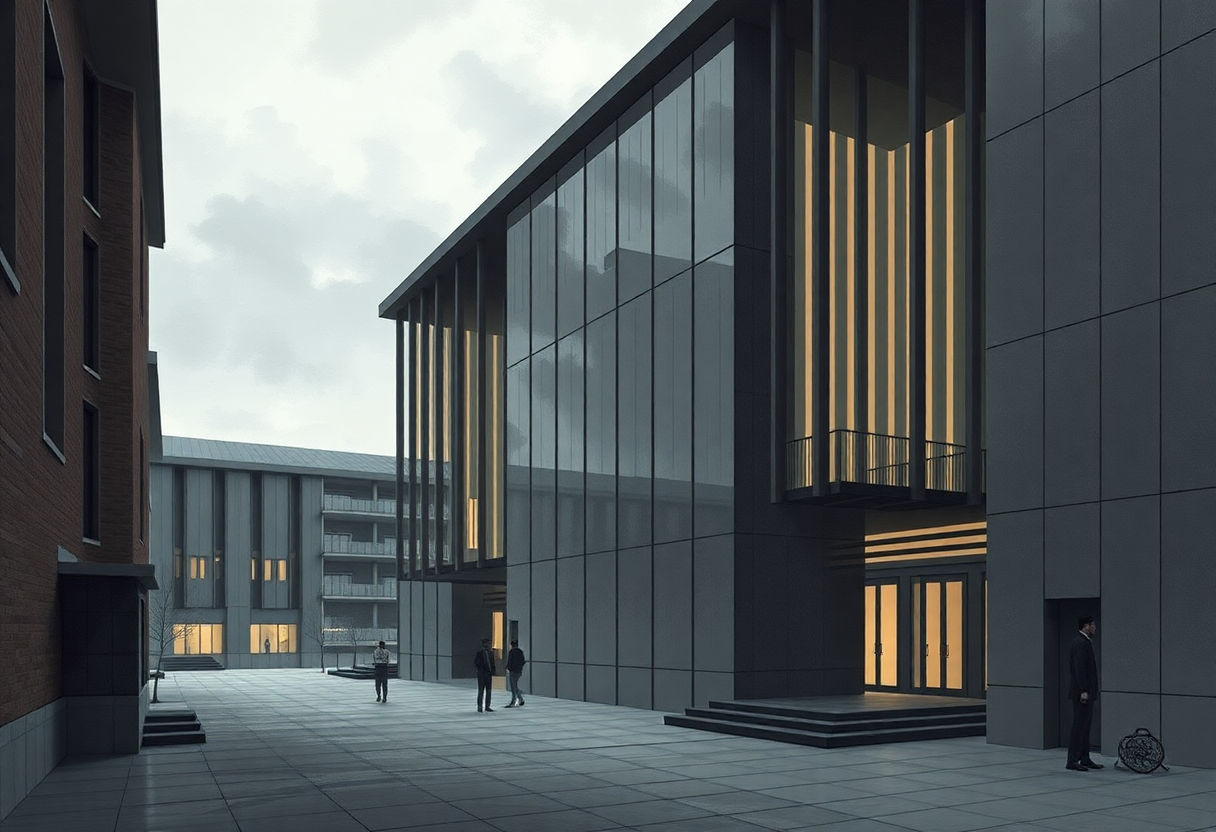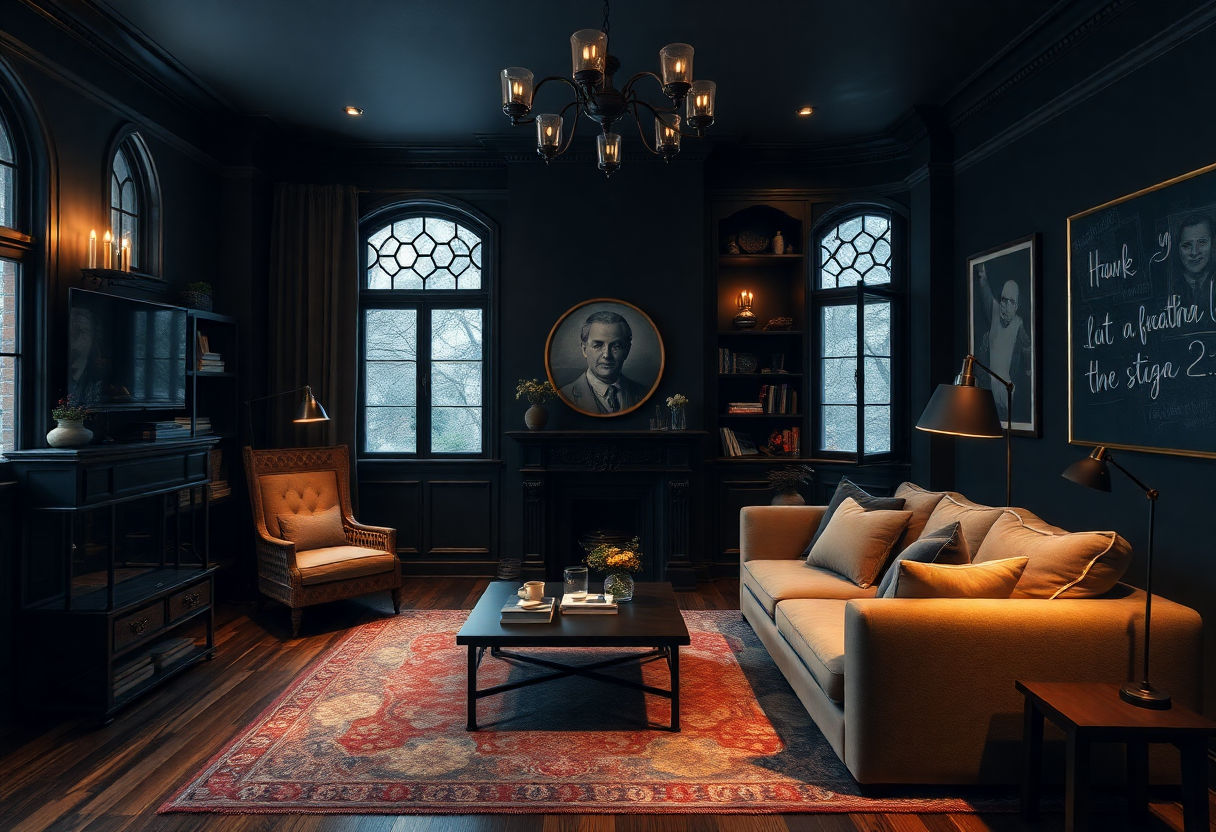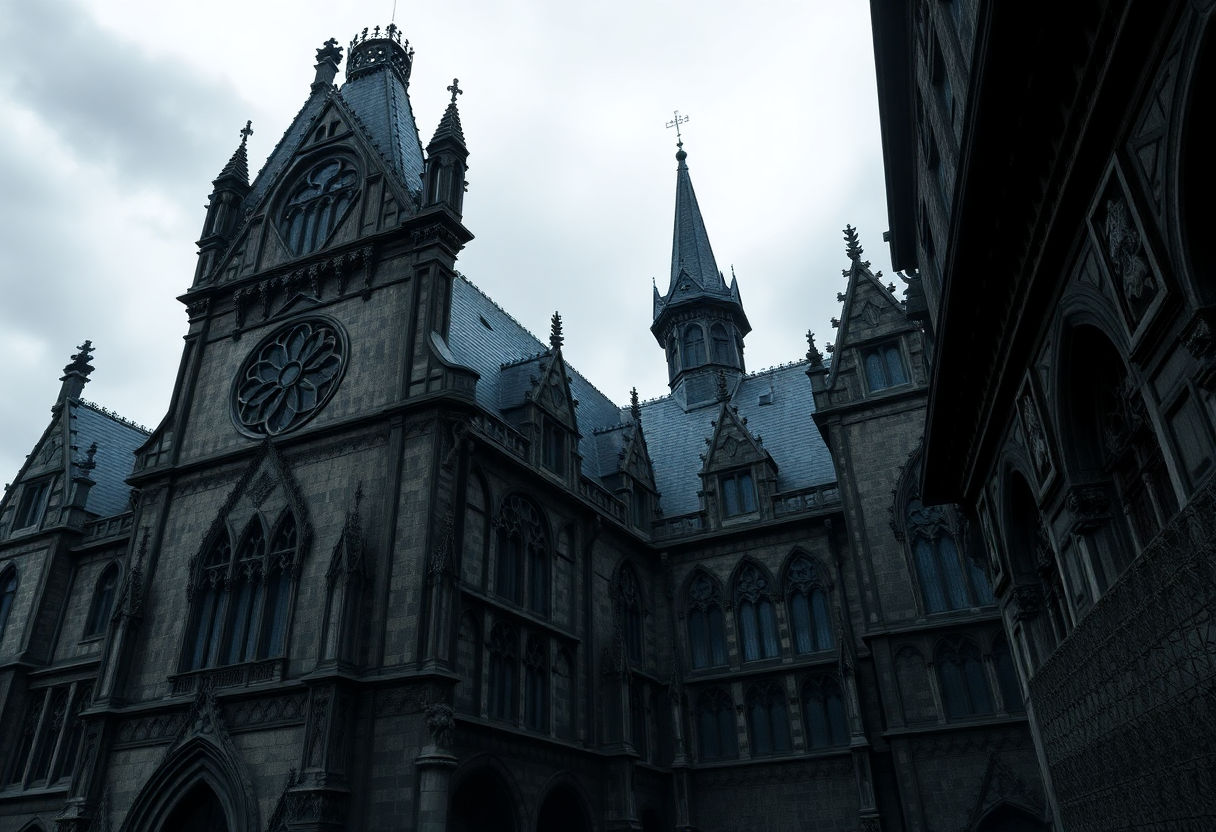Dark academia architecture captivates with its mysterious charm. This style draws from classic Gothic designs, weaving history and culture into its very structure. Picture pointed arches and intricate carvings that tell stories of old. Literature and art breathe life into these buildings, influencing their form and essence. Today, architects blend dark academia elements with modern design, creating stunning spaces with a nod to the past. Its cultural impact resonates, especially in academic settings. Explore iconic structures worldwide and learn how to weave this aesthetic into your own home. Discover the timeless allure of dark academia architecture.
Key Takeaways
- Dark academia architecture draws inspiration from Gothic designs, featuring elements like pointed arches and intricate carvings.
- The design style emphasizes deep colors and dramatic lighting, creating an atmosphere that feels both historical and mysterious.
- Literature and art have significantly influenced this architectural style, adding layers of meaning and depth.
- Modern architects often integrate dark academia elements into contemporary designs, blending the old with the new.
- Cultural significance of dark academia is most visible in educational institutions, where it inspires a love for learning and introspection.
Origins of Dark Academia Architecture

Dark academia architecture finds its roots in old Gothic designs. These designs started in Europe during the Middle Ages, around the 12th century. Gothic architecture is known for its tall, pointed shapes. Buildings often reach for the sky, as if trying to touch the heavens. Many old cathedrals, like the Notre-Dame in Paris, show this style.
Over time, architects adapted these elements. They mixed them with later styles, creating what we now call dark academia. Think of old university campuses like Oxford or Cambridge. These places have tall libraries and old stone halls. They look like something straight out of a classic book.
Key characteristics of Gothic design that influence dark academia include:
- Pointed arches: These arches are sharp and rise high. They add drama and height to buildings.
- Ribbed vaults: These are ceilings with stone ribs that form a web-like pattern. They are strong and look grand.
- Flying buttresses: These are stone supports on the side of walls. They help hold heavy walls up.
Imagine walking under a tall archway with shadows playing on the walls. The feeling is both eerie and inspiring. This unique blend of strength and beauty draws many to dark academia. It’s a style that respects its historical roots while creating a special, thoughtful space.
Key Architectural Features

The allure of dark academia architecture lies in its distinct features. These elements create a mysterious yet inviting atmosphere.
-
Pointed Arches: These arches draw the eye upwards. They create a sense of space and lightness. In many ways, they are like reaching hands, trying to touch the sky.
-
Intricate Carvings: Walls and doorways tell stories through these detailed designs. You might find floral patterns or mythic beings carved with care. Each carving adds depth and mystery.
-
Steep Roofs: The sharp angles of these roofs help keep snow away in colder regions. But they do more than that. They give buildings a tall and commanding look. A steep roof almost seems to reach higher than the sky allows.
-
Grand Libraries and Wooden Panels: Imagine walking into a room lined with dark wooden panels and filled with the fragrance of old books. The blend of wood and books provides warmth. It beckons one to sit, read, and ponder the mysteries of the world.
Using these features, dark academia architecture captures a feeling of timeless wisdom. It draws people in, inviting them to explore its hidden wonders.
Influence of Literature and Art
Literature and art have played a big role in shaping dark academia architecture. These influences bring a rich, mysterious feel to the design.
Literature: Stories often set the mood for dark academia. Think old universities or ancient libraries with endless books. Gothic novels, like Edgar Allan Poe’s tales, paint a picture of this style. They describe old stone buildings, secret passageways, and haunting echoes. Readers often imagine characters wandering candle-lit halls, which adds to the architectural vibe.
Art: Artists capture the depth and drama found in this architecture. Paintings often show moody skies, grand buildings, or shadowy interiors. Artists like Caspar David Friedrich focused on emotional landscapes, which complement dark academia themes. His work showcases moody, quiet scenes that feel both grand and personal.
Together, literature and art bring stories and emotions to dark academia. They guide the visual elements, encouraging architects to create spaces that feel alive with history and mystery. Even today, these influences inspire people to design with both style and substance. The result is architecture that feels timeless, like walking into a classic novel or a dramatic painting.
Dark Academia in Modern Design

Dark academia brings old-world charm into modern spaces. Architects mix the nostalgic feel of the past with today’s sleek designs. They use elements from classic styles to create something new and striking.
Think of tall, arched windows that let in beams of light. They cast beautiful patterns on the floor. These windows remind us of old universities and libraries. Now, they appear in urban homes and offices.
Consider a color palette with deep greens, browns, and grays. It wraps rooms in warmth and comfort. These colors inspire people to relax and think deeply, as if in an old study.
Wooden bookshelves are another feature. They are not just for books. They hold memories and stories. In modern designs, they stand against concrete or metal walls. They serve as a bridge between the past and present.
Furniture often takes center stage. Leather chairs and walnut tables bring a sense of history. They pair well with modern lighting and metal accents. The result is sophisticated but inviting.
Think of these as more than decor choices. They shape how these spaces look and feel. A nod to the past creates a mood of mystery and knowledge. Modern design keeps it fresh and functional.
Modern architects harness the soul of dark academia. They blend it with new ideas, making spaces that are both familiar and surprising. Here, history meets imagination, and each space tells its own story.
Cultural Significance
Dark academia holds a unique place in culture, especially in schools and universities. This style does not just cover buildings. It taps into a love of learning and the mysteries of knowledge. Students often see these structures as more than stone and mortar. They feel a sense of history and academia. Imagine a library with tall bookshelves and dim lighting, echoing with whispers of the past.
Gothic elements make dark academia stand out. Pointed arches, tall windows, and detailed stonework draw the eye. These features remind us of medieval times. They hint at stories and secrets hidden within the walls. Such architecture often stirs feelings of wonder and curiosity.
Academic settings benefit greatly from this architecture. Buildings with these designs can inspire learning. They create a space for thought and reflection. Students feel part of something larger, a continuation of learning that stretches back through time.
Beyond schools, this style appears in literature and films. Think of the mysterious settings in stories like “Harry Potter” or “The Secret History.” These tales often use dark academia to set the mood. They echo feelings of discovery and the unknown.
Dark academia also influences everyday fashion and decor. People choose elements like vintage clothing or antique furniture. They aim for the aesthetic of these grand structures. This shows the style’s reach beyond architecture, touching various areas of life. It’s more than a design. It’s a cultural experience.
Prominent Examples Worldwide
Dark academia architecture boasts stunning examples across the globe. One must-visit spot is the University of Glasgow in Scotland. Its Gothic Revival style captures dark academia’s moody feel. With tall spires and archways, it evokes a sense of awe. The campus feels like stepping back in time.
In England, the University of Oxford delights with its iconic buildings. The Bodleian Library stands out. Its grand halls and vast book collections offer a classic dark academia experience. Walking through its corridors feels like a journey through history.
The Yale University in the United States holds its place among these giants. It blends Collegiate Gothic with a modern touch. Sterling Memorial Library’s towering walls and stained glass set the scene for quiet study and reflection. This grand design reinforces the themes central to dark academia.
The Sorbonne in Paris shines as a beacon of education and dark aesthetic. Its historic stone structures fill one with a sense of deep learning. Inside, every corner whispers tales of scholars and thinkers of the past.
Each of these landmarks shares key features:
- Gothic Influence: Pointed arches, ribbed vaults, and flying buttresses.
- Majestic Scale: Tall towers and grand facades.
- Historic Elements: Use of stone, wood, and detailed carvings.
These examples show how dark academia architecture captures the imagination. They inspire both lovers of history and seekers of beauty. Today, these buildings stand as tributes to the mix of learning, art, and history.
Integrating Dark Academia in Home Design

To bring dark academia into your home, focus on mood and color. Start with deep, rich colors like dark green, deep burgundy, or charcoal gray. These hues create a cozy and moody atmosphere, much like an old library or a study from the past.
Furniture choices matter. Opt for pieces that have a vintage feel. Think of a leather armchair with worn edges or a heavy wooden desk that looks like it has stories to tell. These items add authentic character to the space.
Lighting plays a key role. Use lamps with soft, warm lighting. Choose styles that resemble those found in old colleges or libraries. Table lamps with fringed shades or antique designs work well.
Decorate with books, but not just any books. Leather-bound volumes or aged paperbacks enhance the theme. They add both texture and interest. Stacked or lined neatly on shelves, they become more than just reading material.
Incorporate art and accents. Look for framed prints of old maps, classical artworks, or black and white photographs. These pieces add depth and history to your decor. Small statues or globe display can add an intellectual touch.
Use textiles to complete the look. Think heavy curtains, soft throw blankets, and plush rugs. Rich textures invite you to settle in with a good book, completing the dark academia feel.
With these tips, anyone can bring the charm of dark academia into their home, creating a space full of character and warmth.
Challenges in Dark Academia Architecture

Historic buildings in the dark academia style face many challenges. Upkeep costs can be high. These structures often have complex designs. Think of pointed arches and intricate carvings. Each detail requires special care.
Weather and time take a toll. Stone can crack. Wood can rot. Repairing these materials needs skill. Craftsmen must know old methods. Modern technologies don’t always fit with ancient designs.
Energy efficiency presents another problem. Many old buildings lack proper insulation. Drafty rooms lead to higher heating costs. Upgrading systems without changing appearance requires creative solutions.
Adapting spaces for new uses brings its own challenges. Schools and libraries need tech-ready areas. Adding modern elements like wiring must blend smoothly with the past. Striking a balance is key.
Let’s not forget accessibility. Many historic buildings have steep stairs or long hallways. Making these places easy for everyone to use is a puzzle. Architects face limits but find ways to improve access.
In sum, keeping these buildings loved and lived-in takes work. Challenges are real but not impossible to overcome. The beauty of this architecture makes the effort worthwhile.
Conclusion
Dark academia architecture captivates with its blend of history and mystique. Its Gothic roots and literary influences create spaces that inspire thought and imagination. Today, architects merge these elements with modern design, offering fresh perspectives while honoring the past. This style reminds us of the importance of preserving history, yet adapting it for modern use. As interest grows, new opportunities arise to include dark academia’s unique charm in homes and public spaces, enriching the architectural landscape. Consider this style for your next design to bring its timeless allure into your everyday life.
Frequently Asked Questions
What is dark academia architecture?
Dark academia architecture embraces Gothic and Victorian styles. It features elements like pointed arches, dramatic details, and large windows. These buildings evoke a sense of mystery and timelessness.
How did dark academia architecture originate?
Dark academia architecture finds its roots in Gothic designs from medieval Europe. This style evolved through the Victorian era, blending art, literature, and a focus on classic education.
Why is dark academia so popular today?
Dark academia gained popularity through social media and literature that romanticize this aesthetic. The style appeals to those who appreciate nostalgia, classic themes, and scholarly settings.
Can modern homes integrate dark academia elements?
Yes, modern homes can incorporate dark academia features. Use elements like rich colors, vintage furniture, and gothic decor. These touches bring the dark academia feel into any space.
What challenges do architects face with dark academia architecture?
Restoring and adapting historic dark academia buildings can be difficult. Architects often encounter structural issues and must respect the original design while meeting modern standards.



